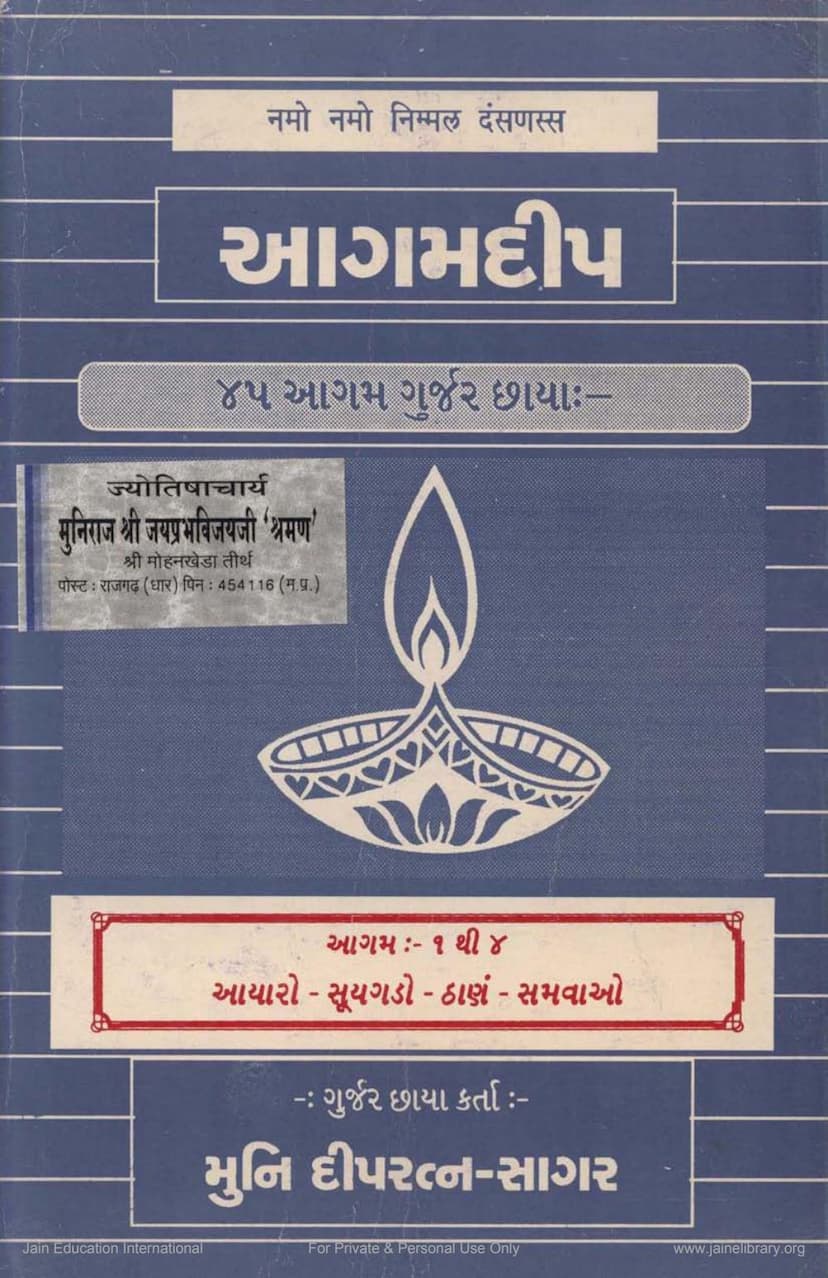Agam Deep 40 Aavassayam Gujarati Anuvaad
Added to library: September 1, 2025

Summary
Here's a comprehensive summary of the provided Jain text, focusing on its content and structure:
The text is titled "Agam Deep 40 Aavassayam Gujarati Anuvaad", published by Agam Shrut Prakashan, with Dipratnasagar and Deepratnasagar listed as authors. The catalog link provided is jainqq.org/explore/005103/1. The publication is a Gujarati translation and commentary ("Gujar Chhaya" meaning Gujarati shadow/explanation) of the Jain Agam text "Aavashyak Sutra" (also known as Aavassayam), specifically focusing on the first Mool Sutra (Chapter 1). The work is attributed to Muni Dippratnasagar.
The text appears to be part of a larger series, indicated by "Agam Deep = 45" and the mention of "Agam-1 to 4" (Aayaro, Suyagado, Thanu, Samavao) on earlier pages, suggesting this is the 45th volume or part of a series dealing with Agam literature. The specific work being summarized is likely Volume 1 of the "Agam Deep" series covering the "Aavashyak Sutra".
Key Aspects and Content:
- Purpose: The primary purpose of this publication is to provide a Gujarati translation and detailed commentary (Gujar Chhaya) of the Aavashyak Sutra, making this fundamental Jain scripture accessible to Gujarati-speaking readers.
- Authorship and Guidance: Muni Dippratnasagar is credited as the author of the Gujarati explanation. The work is inspired by Acharya Shri Devshri Mahayash Sagarsurishwarji Maharaj Saheb and Muni Shri Mohanlalji.
- Sponsorship and Support: Several pages detail the "Mukhya Dravya Sahayak" (main financial supporters) and other contributors who made the publication possible. These include individuals and families like Smt. Naynaben Rameshchandra Shah Parivar, Shantaben Mansukhlal Babaria, Shantaben Shantilal P. Damani, Manjulaben Gunvantlal Vora, and various Jain Sangh/Trusts from Ahmedabad and other locations. This highlights a collaborative effort in bringing this religious text to light.
- Structure of the Aavashyak Sutra: The text systematically breaks down the Aavashyak Sutra, with each section being a "Adhyayan" (chapter). The provided pages cover:
- Adhyayan 1: Samayik (Page 11-12): This section begins with the invocation and Namaskar Mahamantra. It explains the meaning of the five Parameshtis (Arhant, Siddha, Acharya, Upadhyaya, Sadhu) and the significance of the greeting. It then details the practice of Samayik (equanimity/meditation), including the vows of non-violence, truthfulness, non-stealing, celibacy, and non-possession. It also covers the concept of "Maha-mangal" (great auspiciousness).
- Adhyayan 2: Chaturvinsati Stava (Page 12-13): This chapter focuses on the prayer and salutation to the 24 Tirthankaras. It lists them and describes the benefits of venerating them, seeking blessings like health, knowledge, and spiritual peace.
- Adhyayan 3: Vandan (Page 13-14): This section details the proper etiquette and ritual for paying respects (vandan) to a Jain monk or ascetic (Shraman), including asking for permission to approach, touching their feet, asking about their well-being, and seeking forgiveness for any unintentional offense. It also includes the confession of transgressions made throughout the day.
- Adhyayan 4: Pratikraman (Page 14-18): This is a substantial section detailing the process of confession and atonement for sins committed. It elaborates on various types of transgressions (atichars) related to the five vows (Pranavtipata, Mrushavada, Adattadana, Brahmacharya, Parigraha), as well as other categories like improper conduct, disrespect, and errors in scriptural study. It emphasizes repentance and seeking forgiveness.
- Adhyayan 5: Kayotsarga (Page 18-20): This chapter describes the practice of Kayotsarga (abandoning the body or physical self for spiritual practice). It explains how to remain steadfast during this practice, mentioning exceptions and invoking the Tirthankaras. It covers the purpose of Kayotsarga as a means of purification and seeking spiritual progress.
- Adhyayan 6: Pratyakhyan (Pachhakhan) (Page 21-24): This final section details various forms of vows and abstinences undertaken by Jain lay followers (Shravaks/Shramanopasak). It outlines the five Anuvratas (minor vows) and their respective five atichars (transgressions). It also explains the three Guna Vratas (vows of reinforcement) and the four Shiksha Vratas (vows of training) like Samayik, Deshavakashik, Paushadhopavas, and Atithi Samvibhak, along with their associated atichars. Various types of food and other vows (e.g., Ekasana, Eksthana, Ayambil) are also discussed.
- Language and Commentary: The work is in Gujarati, with the "Gujar Chhaya" providing explanations of the Sanskrit/Prakrit terms and verses. The commentary aims to elucidate the spiritual and ethical principles embedded in the Aavashyak Sutra.
- List of Agam Texts: Pages 8, 9, and 10 provide an extensive list of Jain Agam Sutras, indicating the scope of the "Agam Deep" series. This lists the 12 Anga Sutras, 14 Upanga Sutras, 10 Mool Sutras, and other subsidiary texts, mapping them to their respective "Agam Deep" volumes.
- Printing and Composition: Details about the printing press (Navprabhat Printing Press, Ahmedabad) and composition (Shri Graphics, Ahmedabad) are also included.
- Price: The price for "Agam-Deep-Gujar Chhaya" is mentioned as Rs. 2000/-.
In essence, "Agam Deep 40 Aavassayam Gujarati Anuvaad" is a significant publication for Gujarati-speaking Jains, offering a detailed and accessible explanation of the essential Aavashyak Sutra, covering fundamental practices like Samayik, Pratikraman, and various vows. The work is supported by a dedicated community and aims to promote the understanding and practice of Jainism.